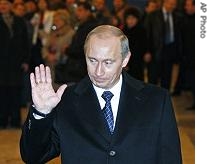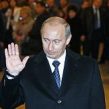
RUSSIA WILL REGAIN DEMOGRAPHIC, ECONOMIC, AND MILITARY STRENGTH, PUTIN CLAIMS
Publication: Eurasia Daily Monitor Volume: 5 Issue: 29
By:

Speaking to a session of the State Council on February 8, President Vladimir Putin outlined his vision of Russia’s development through the year 2020. The State Council is a consultative body incorporating Russia’s regional leaders that Putin created to provide advice from time to time. Last week’s session was expanded to some 750 persons, including members of the religious community, business people, politicians, representatives of the military and security services, government ministers and bureaucrats. There was no discussion or questions – only applause (see EDM, February 11).
Putin recalled the state of decay Russia was in when he came to power, as the second Chechen campaign unfolded in 1999-2000: “Our armed forces were demoralized and not prepared for combat. Military servicemen received a pittance, which even then was not always paid on time. Equipment was becoming outdated at an alarming rate. Our defense industry, meanwhile, was choked by debts and its human resources and production base were shrinking.” Putin confessed that he had saved Russia from such a dire situation thanks to the support of loyal subjects: “The people responded with neither despair nor fear. On the contrary, our people closed ranks and drew together. Not only our military but society itself rose up to defend Russia, to defend our territorial integrity” (www.kremlin.ru, February 8).
Over the course of Putin’s eight years in power, Chechnya was regained, the economy grew dramatically, and Russia “returned to the world stage as a strong state.” In May 2006, Putin announced a package of measures to stimulate the birth rate in an attempt to reverse Russia’s rapid depopulation. Russians followed their leader’s call, to the surprise of specialists and skeptics within the government. According to Putin, “We have checked the falling birth rate and rising death rate. The birth rate grew faster last year than any time in the last 25 years, and more children were born in the country than were born over the last 15 years.” In the next three or four years, Putin announced, “We will succeed in stabilizing the population,” as the birth rate balances the number of deaths, contrary to what experts say. Putin has decreed “a more than 1.5-fold reduction in the death rate, and a raise of the average life expectancy to 75 years by 2020.”
These figures come from the president’s official website (www.kremlin.ru), but they are somewhat idiosyncratic and require explanation. Of course, the birth rate did not grow 15-fold. In 2007, 1,602,387 children were born in Russia, while in 2006 there were 1,479,637 (RIA-Novosti, February 1). The previous steep growth in birth rates happened after 1980 and peaked at 2.6 million babies a year from 1983 to 1987. Later the birth rate steeply fell, averaging 1.3 million a year from 1993 to 2004. These so-called “demographic waves” are an echo of the steep decline in the population of Russia during World War II and the subsequent baby boom of the 1950s. The latest increase in the number of births began in 2005, long before Putin announced his pro-natal stimulation package. These babies primarily are the offspring of the many Russian women born between 1983 and 1987, who are now past the age of 20 and starting to marry and give birth. In some five years this “demographic wave” will inevitably ebb, the birth rate in Russia will again plummet – most likely to under a million a year – while the death rate will grow substantially as Russian baby boomers pass 60 (see Demographic Modernization in Russia, 1900-2000, Moscow: New Publishers, 2006).
In his speech last week, Putin repeatedly called for a “transition to the innovative track of development” in all spheres of Russian life. At least in his demographic arithmetic, Putin was indeed “innovative.”
Putin’s speech was screened live by Russian TV channels and was fully repeated that evening in prime time. The event had the scent of electioneering, but Putin is not up for election, Russian elections are a farce anyway, and “the people” do not decide anything – they are subjects, not citizens.
Putin was, in fact, mostly speaking to the audience gathered before him in the Kremlin, telling the richest and most powerful people in the land to keep calm. According to his message: the demographic crunch will be solved, the state will be strong, and the economy will grow and “innovate,” making Russia a world leader by 2020. However, NATO is encroaching on Russia and “the world has entered a new spiral in the arms race,” Putin warned. In response “Russia will begin production of new weapons,” better than Western ones, but do not worry, said Putin, defense spending will not increase dramatically, and, “We will not be drawn into a costly confrontation or a new arms race.”
The ruling elite indeed wants a strong Russia and is genuinely afraid of the West imposing its standards of press freedom, democracy, and responsible governance, which could destroy Putin’s kleptocracy. At the same time the multimillionaires and billionaires who have amassed incredible wealth under Putin and are the top echelon of his so-called vertical power structure. These top bureaucrats are at the same time businessmen who have made fortunes in oil, gas, metals, and other trade deals with the West. They do not want to share money and power with army generals or the defense industry. They do not need a showdown with the West or a new Cold War, which could harm their business.
But the divide remains between the hawkish siloviki and business-like pragmatists. Often one person has such a split personality, like Putin himself, who in his heart may wish that Russia regains its Soviet imperial glory and superpower status to openly challenge the West, while his checkbook calls for restraint and business collaboration. This prevailing split personality may explain the schizophrenic nature of Putin’s speech and Russia’s overall policymaking.




